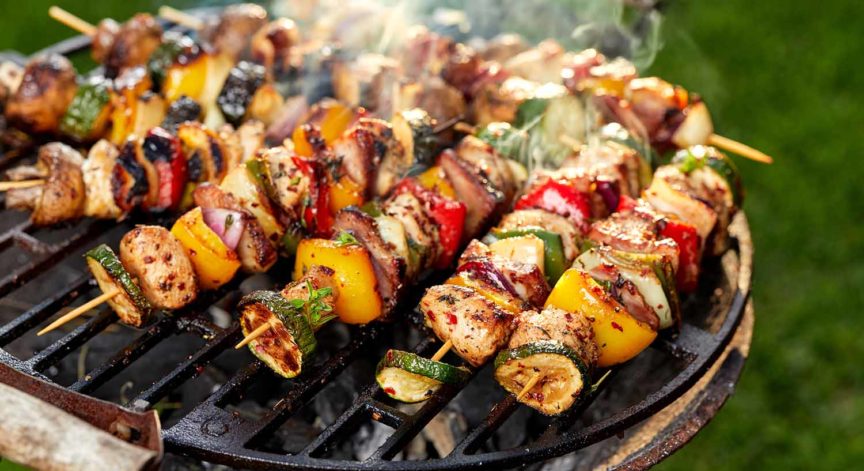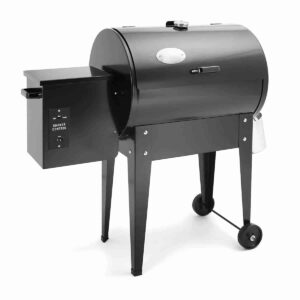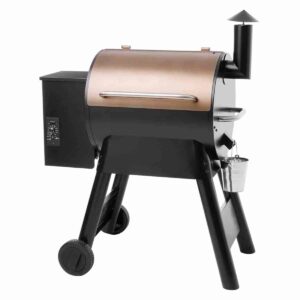Grilling with skewers can be difficult without the ultimate guide. How do you keep wooden skewers from catching on fire? What about metal skewers? Before you risk setting fires where they don’t belong, check some of this out.
What are the ultimate guide lines on grilling with skewers? Watch your grill flame so you don’t overly char bamboo skewers, ensure the food is securely on the skewer, and ensure you cook everything evenly on each side.
We all love barbeques during the summer, and what’s better than food? Food on a stick! Food on a stick is popular no matter what age or person you’re catering to. Who wants to eat a block of flavored ice? One holding a stick. Who wants barbeque? Someone offered a kabob.
Pointers on Using Metal or Wooden Skewers
Wooden Skewers vs. Metal Skewers
There’s two kinds of skewers: wooden or metal. Most wooden skewers are made of bamboo, but I still say wooden because of those few mountain men who insist on stripping an oak tree for their special kabobs.
Wooden skewers are disposable, which makes them great for places without anywhere to wash dishes. But many people have a fear of setting them on fire. Even if you do set the tip of them on fire, which is difficult with bamboo skewers, you can quickly blow it out with a quick puff.
Metal skewers are reusable and thus easier on the environment. They won’t catch on fire, but you need to be careful as they will get incredibly hot. You can buy special ones with handles that won’t burn anyone who touches them, but they’re more expensive. Even the cheap metal skewers are more expensive than bamboo skewers.
Bamboo Skewers
Bamboo is what the majority of wooden skewers are made of, with a limited exception of specialty skewers for people who want to explore playing with different woods. They can be soaked, compared to metal skewers which cannot, to impart more flavor into the food.
Bamboo is ideal for skewers because its smooth texture makes it easier to slide food onto it without splinters going into the food. It also isn’t as flammable as other kinds of wood, usually only charring while on a grill.
Can Bamboo Skewers Go on a Grill?
Bamboo skewers can go on the grill with no problem. If you’re worried about them dramatically catching on fire, you really have nothing to worry about. The worst you’ll see is a little baby flame, comparable to the flame of a tea light candle.
Bamboo skewers will char, however. This simply means the ends will probably be blackened, and you may see a few flames, though those will most likely quickly come and go. If you’re really worried about the open flame and skewer, you can always soak them.
Do You Need to Soak Bamboo Skewers Before Putting Them on the Grill?
If you experience any issues of splitting while trying to slide food onto the skewer, you may want to soak them. The wood may just be too dry to stay together and is splintering apart, as is frequent with cheap ones. If you end up with cheap, thin skewers, you may want to soak them to reduce char.
If you decide to soak the skewers, you’ll only need a large, shallow pan and some water. Spread the skewers out evenly in a single layer and allow the water to seep into them. You can soak them for as little at 30 minutes or up to 4 hours.
Another option is to soak them in alcohol or another flavored liquid. The skewer will infuse the food with the flavor of the liquid as it cooks, giving you another layer of flavor in your food. Keep in mind that if you have any alcohol content soaked into the skewer, you may see some more charring.
Metal Skewers
Metal BBQ skewers are usually made of stainless steel. The skewers may be flatter and wider to add stability or simply round. Some have a handle to prevent burns when the skewer is grabbed while others don’t.
Metal skewers are frequently bought by people because:
- They also don’t char at all
- They’re inexpensive
- You never risk splintering
- Don’t have to soak them
However,
- They’re more expensive
- You have to wash them after each use
- Metal conducts heat more, so risk of burning people is higher
- You can’t infuse flavor into them
Wide Flat Metal Skewers for Grilling
A new idea to come to the grilling idea was for wider, flatter metal skewers. The issue many people were experiencing with typical round skewers was their food swinging around. With different pieces swinging around at different times, it made it hard to ensure all sides were evenly cooked.
If you have the option between completely round skewers and more flat, wide skewers, you should always go with the wider, flatter skewers. The reason is, the wider and flatter the skewer, the better it will hold the meat.
There are even some specialty skewers, which look almost like swords but are designed to slice into meat. They are then laid over the fire to grill. This is common with specialty skewered kabobs, which there are hundreds of variations on throughout the world.
Do I Need to Do Anything Different When Grilling with Metal Skewers?
You really don’t need to do anything different when grilling with metal skewers than with bamboo skewers. The biggest thing to remember is that metal conducts heat unlike bamboo, so be careful and warn everyone who’s eating them of the hot metal.
Obviously, you don’t need to soak the metal skewers before you put the meat on them like you do for wood skewers, but you may need to soak them afterward. Metal skewers can be a hard thing to clean, so make sure you’re ready to deal with grilled on grease or can let them sit and soak.
How Do You Grill Kabobs?
Shish kabobs, usually just called kabobs, refers to meat and vegetables cut into one inch cubes and put on a skewer. “Kabobs,” translated, simply means a meat dish of Middle Eastern origins. In America, most skewered meats and vegetables have been come to be known as kabobs.
Some common ingredients for a kabob is onion, bell pepper, various meats, mushrooms, and a variety of other foods. There are many specialties of various skewered meat dishes from all around the world, but in America, kabob has come to mean any of them.
While kabobs are not necessarily always cooked on a grill, they usually are. This allows the meat to take on the smoky grill flavor as well as get a nice char on it. With wooden skewers, the skewer has a nice char as well.
The key to grilling great kabobs is making sure they cook evenly. Make sure before you place anything on the grill, it’s at medium temperature. Then, as the kabobs cook, rotate them regularly, so they don’t burn on one side while being raw on the other.
How to Know When Kabobs Are Done Being Grilled
Kabobs don’t take long to grill. The meat should be done with about 2-4 minutes on each side. If you have any concerns about whether it’s done or not, you should use a thermometer to check the internal temperature. Be careful to not touch the skewer, however, or you will get a false reading.
If you’re making a different kind of kabob, without meat, it’s easier to tell. Once vegetables are tender enough to eat, pull them from the grill. You want to make sure not to overcook them, or they’ll become gross and soggy.
Always make sure to thoroughly cook all meats before serving. If you leave any kind of beef or pork cooked below well done, ensure your guests know before they eat in case of any food sensitivities.
Other Kabobs
Not all kabobs have to be meat and vegetables cooked on the grill. For parties, you can also make fruit kabobs with fresh fruit for a no grilling option or, for vegetarians and vegans, fill a skewer with all vegetables for a vegetarian kabob.
How to Cook the Best Kabobs
Kabobs are a great option, especially during the summer. You can certainly just go for it, skewering whatever you like onto a bamboo or metal skewer. However, there are a few other things you can do to ensure it’ll be as good as possible.
- Marinate your meat and vegetables. While some foods are great with a simple of dash of salt and pepper, kabobs really shine with a bit of marinating to make strong flavors come through.
- Choose vegetables that won’t take a long time to cook. Your meat will be done in ten minutes or less, so don’t try to put an inch-thick cube of potato on your skewer and think it’ll be done at the same time as the rest of the skewer. Onion, squashes, and bell peppers are all good ideas to try.
- Keep your kabobs on the grill. There’s nothing worse than having a beautiful kabob almost ready, and then it falls in between the grate and down to the ashy fire below. So be careful and make sure to lay them diagonally atop the grate so they won’t fall down.
The Kabob Marinade
What about the marinade? Everywhere you see kabobs, you’ll probably see mention of a marinade. What is it?
A marinade is a sauce of various spices and flavorings mixed with vinegar and oil created for soaking meat or other food before cooking. The marinade not only flavors the meat but softens it and makes it more tender after grilling.
Because you can use any kind of meat for kabobs, you can use nearly any marinade. A marinade is very easy to put together using the basic formula and then changing the flavorings based on your tastes and preferences. The basic formula is simply
- Lemon juice, wine, vinegar, etc., are all acids that will lend a bright flavor to the meat as well as tenderize it. You’ll want to use strong acids, such as straight distilled vinegar, in moderation while using weaker acids, like lemon juice or more balanced vinegar, in heavier amounts to maintain the same effect.
- Extra virgin oil, canola oil, sesame oil, whatever’s fitting to your tastes that day. You don’t want to turn your marinade into an oil slick, but the oil will carry the flavorings into the meat and trap them there.
- This is literally anything you want, from spices to sugars to herbs. Keep in mind, salt will also amplify flavors, so make sure to add a pinch of that to ensure your meat isn’t too bland.
What Not to Include on Your Kabob
Kabobs can easily be ruined if only part of it is cooked. You can prevent this to a degree with properly rotating the skewers on the grill, but there’s a bit more you can do as well.
When you assemble your kabob, think of how everything cooks. If you know the two ingredients have very different cook times, you shouldn’t put them both on the same skewer. For instance, a small chunk of bell pepper will cook much faster than a cube of potato.
If you can, go ahead and make kabobs where each skewer has each ingredient. This way, each ingredient can be perfectly cooked without being stuck on a skewer with ingredients that will take significantly longer to cook.
If you can’t or simply don’t want to make a bunch of bland skewers full of the same food instead of a variety of meats and vegetables, try to group them together keeping cooking time in mind.
Skewered, Grilled Foods Aside from Kabobs
Everyone in America just habitually calls skewered, grilled meat kabobs. This isn’t quite accurate, as there are actually many different kinds from different regions and cultures.
While not quite comprehensive of every type of skewered kabob, here’s a tasting.
- Sosatile, from Africa
- Lyulya kebab, from Armenia
- Bihari kabab, from Bihar, India
- Chuanr, from China
- Souvlaki, from Cyprus
- Joujeh kabab, from Iran
- Espetadas, from Portugal
- Pincho moruno, from Spain
- And many, many more.
Each kind has a different flavor scheme inspired by the different cultures. If you want to explore new cultures through their food, you definitely can through skewers.
What Are the Most Common Skewered Kabobs?
There are so many other kinds of skewered kabobs, but some are more easily found than others.
- Satay is a Southeast Asian dish, made of spicy diced or sliced meats. It’s frequently sold as a street food and was created because of Indian kebabs.
- Shashlik means skewered meat and originally, was lamb. Now, you can find it in any meats you like. It’s commonly found in Russia and Central Asia.
- Ražnjići is a Western Balkan dish similar to shish kebabs and satay.
Of course, you never know what someone may call the same skewered, grilled food you know as kabobs. Many countries have their own name or names for grilled, skewered food. Luckily, in America, you’re pretty safe just saying kabob.
What About Those Kabobs That Aren’t Skewered?
Americans know kabobs as skewered, grilled food, but that actually isn’t even the typical kabob. Most kabobs are a simple meat dishes, usually Middle Eastern or Indian in style. There are even some that are vegetarian and/or made to Muslim customs and requirements.
If you want a basic starter place to look at the other kinds of kebabs, as Google is overwhelming, check out this article on just 20 different kinds of kabobs: https://www.crazymasalafood.com/top-20-types-kebab/
Common Issues with Skewered, Grilled Food
There are a few issues you may run into while trying to grill your kabobs. Here’s a list compiled of some of the most common ones.
Stop food from slipping off your metal skewer by buying flat skewers and keeping the tip up. Metal skewers are notoriously bad at keeping food in place. If you’ve already bought a flat, wide metal skewer, your only other help is to make sure to keep that tip up, so nothing falls off. You can also switch to bamboo, which will grip food better.
If your wooden skewers are charring too much, soak them for a couple hours. I know, I said you don’t have to soak your bamboo skewers. But if you haven’t been and you just keep ending up with blackened skewers, you may just have to try soaking them. Some skewers are just drier and of lower quality and will be more likely to burn.
You can cook skewers in the oven in case of a rainy day. If you were planning a barbeque and it suddenly starts raining, you can still have your kabobs. Make sure you soak the skewers as they’ll char and stink up your house badly if you don’t.
Tough, hard to chew meat is caused by overcooking. Remember, you’ve only got an inch cube of meat. That won’t take long to cook, ten minutes at about medium heat at most. Any more than that and you’ll end up with dried out meat on a stick.
Check out our Recent Posts
Z Grills Review
If you’re looking for a grill that will last, Z Grills is the way to go. Z grills are made of the best quality materials...
Read MorePit Boss Pellet Grill Review
Pit Boss is one of many when it comes to manufacturers of wood pellet grills and smokers. If you have spent any amount of time...
Read More10 Fun Benefits of Taking an Online Cooking Class
There’s never been a better time to take an online cooking class. With the continued popularity of online learning, there are more and more exciting...
Read More



